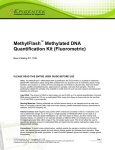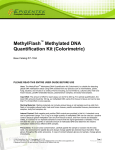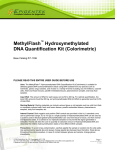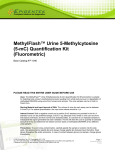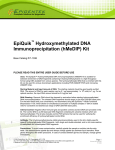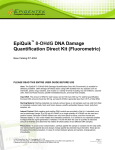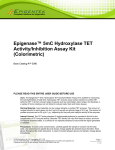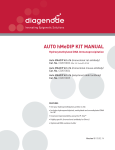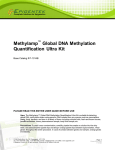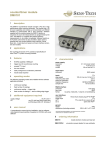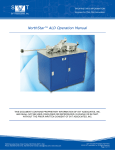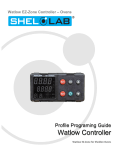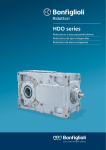Download MethylFlash ™ Hydroxymethylated DNA Quantification Kit
Transcript
EPIGENTEK Complete Solutions for Epigenetics MethylFlash™ Hydroxymethylated DNA Quantification Kit (Fluorometric) Base Catalog # P-1037 PLEASE READ THIS ENTIRE USER GUIDE BEFORE USE Uses: The MethylFlash™ Hydroxymethylated DNA Quantification Kit (Fluorometric) is suitable for detecting global DNA hydroxymethylation status using DNA isolated from any species such as mammals, plants, fungi, bacteria, and viruses in a variety of forms including but not limited to cultured cells, fresh and frozen tissues, paraffin-embedded tissues, plasma/serum samples, and body fluid samples. This kit is particularly suitable for samples only available in small amounts such as laser capture microdissection samples and embryos. Input DNA: The amount of DNA for each assay can be 20-200 ng. For optimal quantification, the input DNA amount should be 100 ng, as hydroxymethylated DNA (hmDNA) is generally less than 0.6% of total DNA. Starting Material: Starting materials can include various tissue or cell samples such as cells from flask or microplate cultured cells, fresh and frozen tissues, paraffin-embedded tissues, plasma/serum samples, body fluid samples, etc. Internal Control: Both negative and positive DNA controls are provided in this kit. A standard curve can be performed (range: 0.2 to 5 ng) or a single quantity of hydroxymethylated DNA can be used as a positive control. Because global hydroxymethylation can vary from tissue to tissue, and from normal and diseased states, it is advised to run replicate samples to ensure that the signal generated is validated. This kit will allow the user to quantify an absolute amount of hydroxymethylated DNA and determine the relative hydroxymethylation states of two different DNA samples. Precautions: To avoid cross-contamination, carefully pipette the sample or solution into the strip wells. Use aerosol-barrier pipette tips and always change pipette tips between liquid transfers. Wear gloves throughout the entire procedure. In case of contact between gloves and sample, change gloves immediately. 110 Bi County Blvd. Ste. 122, Farmingdale, NY 11735 Tel: 1-877-374-4368 ■ Fax: 1-718-484-3956 ■ E-mail: [email protected] ■ Web: www.epigentek.com © Epigentek Group Inc. All rights reserved. Products are for research use only. Page 1 Printed 2014-10-03 P-1037 EPIGENTEK Complete Solutions for Epigenetics KIT CONTENTS Component 48 Assays Cat. #P-1037-48 96 Assays Cat. #P-1037-96 Storage Upon Receipt HF1 (10X Wash Buffer) 14 ml 28 ml 4°C HF2 (Binding Solution) 5 ml 10 ml RT HF3 (Negative Control I, 20 µg/ml)* 10 µl 20 µl –20°C HF4 (Negative Control II, 20 µg/ml)* 10 µl 20 µl –20°C HF5 (Positive Control, 20 µg/ml)* 10 µl 20 µl –20°C HF6 (Capture Antibody, 1000 µg/ml* 4 µl 8 µl 4°C HF7 (Detection Antibody, 400 µg/ml)* 8 µl 16 µl –20°C HF8 (Enhancer Solution)* 8 µl 16 µl –20°C HF9 (Fluoro Developer)* 8 µl 16 µl –20°C HF10 (Fluoro Enhancer)* 8 µl 16 µl 4°C HF11 (Fluoro Dilutor) 4 ml 8 ml RT 8-Well Assay Strips (With Frame) 6 12 4°C User Guide 1 1 RT * Spin the solution down to the bottom prior to use. Note: The HF3 Negative Control I is an unmethylated polynucleotide containing 20% of cytosine. The HF4 Negative Control II is a methylated polynucleotide containing 20% of 5-methylcytosine. The HF5 Positive Control is a hydroxymethylated polynucleotide containing 20% of hydroxymethylcytosine. SHIPPING & STORAGE The kit is shipped in three parts: the first part at ambient room temperature, and the second and third parts on frozen ice packs at 4°C. Upon receipt: (1) Store HF3, HF4, HF5, HF7, HF8 and HF9 at –20°C away from light; (2) Store HF1, HF6, HF10, and 8-Well Assay Strips at 4°C away from light; (3) Store HF2 and HF11 at room temperature away from light. Note: Check if wash buffer, HF1, contains salt precipitates before using. If so, warm (at room temperature or 37°C) and shake the buffer until the salts are re-dissolved. All components of the kit are stable for 6 months from date of shipment, when stored properly. MATERIALS REQUIRED BUT NOT SUPPLIED Adjustable pipette Aerosol resistant pipette tips Fluorescence microplate reader capable of reading fluorescence at excitation 530 and emission 590 1.5 ml microcentrifuge tubes 110 Bi County Blvd. Ste. 122, Farmingdale, NY 11735 Tel: 1-877-374-4368 ■ Fax: 1-718-484-3956 ■ E-mail: [email protected] ■ Web: www.epigentek.com © Epigentek Group Inc. All rights reserved. Products are for research use only. Page 2 Printed 2014-10-03 P-1037 EPIGENTEK Complete Solutions for Epigenetics Incubator for 37°C incubation Plate seal or Parafilm M Distilled water 1 X TE buffer pH 7.5 to 8.0 1 X PBS pH 7.2 to 7.5 Isolated DNA of interest GENERAL PRODUCT INFORMATION Quality Control: Each lot of the MethylFlash™ Hydroxymethylated DNA Quantification Kit (Fluorometric) is tested against predetermined specifications to ensure consistent product quality. Epigentek guarantees the performance of all products in the manner described in our product instructions. Product Warranty: If this product does not meet your expectations, simply contact our technical support unit or your regional distributor. We also encourage you to contact us if you have any suggestions about product performance or new applications and techniques. Safety: Suitable lab coat, disposable gloves, and proper eye protection are required when working with this product. Product Updates: Epigentek reserves the right to change or modify any product to enhance its performance and design. The information in this User Guide is subject to change at any time without notice. Thus, only use the User Guide that was supplied with the kit when using that kit. Usage Limitation: The MethylFlash™ Hydroxymethylated DNA Quantification Kit (Fluorometric) is for research use only and is not intended for diagnostic or therapeutic application. Intellectual Property: The MethylFlash™ Hydroxymethylated DNA Quantification Kit (Fluorometric) and methods of use contain proprietary technologies by Epigentek. A BRIEF OVERVIEW DNA methylation occurs by the covalent addition of a methyl group at the 5-carbon of the cytosine ring, resulting in 5-methylcytosine (5-mC). In somatic cells, 5-mC is found almost exclusively in the context of paired symmetrical methylation of the dinucleotide CpG, whereas in embryonic stem (ES) cells, a substantial amount of 5-mC is also observed in non-CpG contexts. The biological importance of 5-mC as a major epigenetic modification in phenotype and gene expression has been widely recognized. Quite recently, a novel modified nucleotide called 5-hydroxymethyl-cytosine (5-hmC) has been detected to be abundant in mouse brains and embryonic stem cells. 5-hydroxymethylcytosine was first seen in bacteriophages in 1952. In mammals, it can be generated by the oxidation of 5-methylcytosine, a reaction mediated by the Tet family of enzymes and Dnmt proteins. It is a hydroxylated and methylated form of cytosine. 110 Bi County Blvd. Ste. 122, Farmingdale, NY 11735 Tel: 1-877-374-4368 ■ Fax: 1-718-484-3956 ■ E-mail: [email protected] ■ Web: www.epigentek.com © Epigentek Group Inc. All rights reserved. Products are for research use only. Page 3 Printed 2014-10-03 P-1037 EPIGENTEK Complete Solutions for Epigenetics Unmethylated DNA Methylated DNA Hydroxymethylated DNA T-C-G-T-C-G-A-C-G T-mC-G-T-mC-G-A-mC-G T-hmC-G-T-hmC-G-A-hmC-G The broader functions of 5-hmC in epigenetics are still a mystery today. However, a line of evidence does show that 5-hmC plays a role in DNA demethylation, chromatin remodeling, and gene expression regulation, specifically in brain-specific gene regulation: 1) 2) 3) 4) Conversion of 5-mC to 5-hmC greatly reduced the affinity of MBD proteins to methylated DNA. The observation that formation of 5-hmC by oxidative damage or by addition of aldehydes via DNMTs prevents DNMT-mediated methylation of the target cytosine 5-hmC may recruit specific binding proteins that alter chromatin structure or DNA methylation patterns. 5-hmC accounts for roughly 40 percent of the methylated cytosine in Purkinje cells and 10 percent in granule neurons. Because of the presence of 5-hmC in DNA with unclear functions in gene regulation and the discovery of the enzymes that produce 5-hmC, it is considered rather important to know the distribution of this base in different cell types and in different compartments of the genome of mammalians. It is particularly important to identify hydroxymethylation status in human cell/tissues with and without diseases. Several chromatography-based techniques such as HPLC and TLC mass spectrometry are used for detecting 5-hmC. However, these methods are time consuming and have low throughput with high costs. Currently used methylated DNA analysis methods including restriction enzyme digestion and bisulfite or MeDIP-mediated MS-PCR and sequencing are also not suitable for 5-hmC detection, as 5-hmC and 5-mC are virtually indistinguishable with these methods. To address this problem, Epigentek offers the MethylFlash™ Hydroxymethylated DNA Quantification Kit (Fluorometric) which uses a unique procedure to quantify global DNA hydroxymethylation. The kit has the following advantages and features: Fluorometric assay with easy-to-follow steps for convenience and speed. The entire procedure can be finished within 3 hours and 20 minutes. High sensitivity, of which detection limit can be as low as 10 pg of hydroxymethylated DNA. High specificity with no cross-reactivity to unmethylated cytosine and methylcytosine. Only hydroxymethylated DNA (5-hmC) is detected. Universal positive and negative controls are included, which are suitable for quantifying hydroxymethylated DNA from any species. Strip-well microplate format makes the assay flexible: manual or high throughput analysis. Simple, reliable, and consistent assay conditions. References 1. Robertson KD. Nat Rev Genet. 6:597-610, 2005. 2. Kriaucionis S et al: Science. 324: 929-930, 2009. 3. WYATT GR et al: Biochem J. 55:774-8, 1953. 4. Tahiliani M et al: Science. 324: 930-935, 2009. 5. Valinluck V et al: Nucleic Acids Res. 32: 4100-4108. 2004. 6. Valinluck V et al: Cancer Res. 67:946-50, 2007. 7. Jin SG et al: Nucleic Acids Res. 38: e125, 2010. 110 Bi County Blvd. Ste. 122, Farmingdale, NY 11735 Tel: 1-877-374-4368 ■ Fax: 1-718-484-3956 ■ E-mail: [email protected] ■ Web: www.epigentek.com © Epigentek Group Inc. All rights reserved. Products are for research use only. Page 4 Printed 2014-10-03 P-1037 EPIGENTEK Complete Solutions for Epigenetics PRINCIPLE & PROCEDURE The MethylFlashTM Hydroxymethylated DNA Quantification Kit (Fluorometric) contains all reagents necessary for the quantification of global DNA hydroxymethylation. In this assay, DNA is bound to strip wells that are specifically treated to have a high DNA affinity. The hydroxymethylated fraction of DNA is detected using capture and detection antibody and then quantified fluorometrically by reading the RFU (relative fluorescence units) with a fluorescence spectrophotometer. The amount of hydroxymethylated DNA is proportional to the fluorescence intensity measured. 80000 Hydroxym ethylated DNA 70000 Methylated DNA 60000 Unm ethylated DNA RFU 50000 40000 30000 20000 10000 0 0 0.1 0.5 1 2 5 20 Input DNA (ng) Schematic procedure of the MethylFlash™ Hydroxymethylated DNA Quantification Kit (Fluorometric). Fig. 1. Demonstration of high sensitivity and specificity of 5-hydroxymethylcytosine detection achieved by the MethylFlash™ kit. Synthetic unmethylated DNA (contains only cytosine), methylated DNA (contains only 5methylcytosine), and hydroxymethylated DNA standard (contains only 5-hydroxymethylcytosine) were added into the assay wells at different concentrations and then measured with the MethylFlash™ Hydroxymethylated DNA Quantification Kit (Fluorometric). ASSAY PROTOCOL For the best results, please read the protocol in its entirety prior to starting your experiment. Starting Materials Input DNA Amount: DNA amount can range from 20 ng to 200 ng per reaction. An optimal amount is 100 ng per reaction. Starting DNA may be in water or in a buffer such as TE. DNA Isolation: You can use your method of choice for DNA isolation. Epigentek offers a series of genomic DNA isolation kits for your convenience. 110 Bi County Blvd. Ste. 122, Farmingdale, NY 11735 Tel: 1-877-374-4368 ■ Fax: 1-718-484-3956 ■ E-mail: [email protected] ■ Web: www.epigentek.com © Epigentek Group Inc. All rights reserved. Products are for research use only. Page 5 Printed 2014-10-03 P-1037 EPIGENTEK Complete Solutions for Epigenetics DNA Storage: Isolated genomic DNA can be stored at 4°C (short term) or –20°C (long term) until use. 1. Preparation of 1X Wash Buffer (HF1) 48-Assay Kit: Add 13 ml of HF1 10X Wash Buffer to 117 ml of distilled water (pH 7.2-7.5). 96-Assay Kit: Add 26 ml of HF1 10X Wash Buffer to 234 ml of distilled water (pH 7.2-7.5). Note: This Diluted HF1 1X Wash Buffer can now be stored at 4°C for up to six months. All other diluted solutions should be kept on ice at all times and should be discarded if not used within the same day. 2. Preparation of Diluted Positive Control (HF5) Single Point Control Preparation: Dilute HF5 Positive Control with 1X TE buffer to 2 ng/µl (1 µl of HF5 + 9 µl of TE buffer). Suggested Standard Curve Preparation: First, dilute HF5 to 5 ng/µl (3 µl of HF5 + 9 µl of 1X TE buffer). Then, further prepare five different concentrations with the 5 ng/µl diluted HF5 and 1X TE into 0.2, 0.5, 1.0, 2.0, and 5 ng/µl according to the following dilution chart: Tube HF5 (5 ng/µl) 1X TE Resulting HF5 Concentration 1 0.5 µl 12.0 µl 0.2 ng/µl 2 1.0 µl 9.0 µl 0.5 ng/µl 3 1.0 µl 4.0 µl 1.0 ng/µl 4 2.0 µl 3.0 µl 2.0 ng/µl 5 5.0 µl 0.0 µl 5.0 ng/µl 3. DNA Binding a. Predetermine the number of strip wells required for your experiment. Carefully remove un-needed strip wells from the plate frame and place them back in the bag (seal the bag tightly and store at 4°C). b. Add 80 µl of HF2 Binding Solution to each well. c. Add 1 µl of HF3, 1 µl of HF4, 1 µl of Diluted HF5 (see note below), and 100 ng of your Sample DNA (1-8 µl) into the designated wells depicted in Table 1 or Table 2. Mix solution by gently tilting from side to side or shaking the plate several times. Ensure the solution coats the bottom of the well evenly. Note: (1) For a single point control, add 1 µl of HF5 at a concentration of 2 ng/µl, as prepared in Step 2; for the standard curve, add 1 µl of Diluted HF5 at concentrations of 0.2 to 5 ng/µl (see the chart in Step 2). The final amounts should be 0.2, 0.5, 1, 2, and 5 ng per well. (2) For optimal binding, sample DNA volume added should not exceed 8 µl. (3) To ensure that the HF3, HF4, Diluted HF5, and sample DNA are completely added into the wells, the pipette tip should be put into the HF2 solution in the well and aspirated in/out 1-2 times. d. Cover strip plate with plate seal or Parafilm M and incubate at 37°C for 90 min. 110 Bi County Blvd. Ste. 122, Farmingdale, NY 11735 Tel: 1-877-374-4368 ■ Fax: 1-718-484-3956 ■ E-mail: [email protected] ■ Web: www.epigentek.com © Epigentek Group Inc. All rights reserved. Products are for research use only. Page 6 Printed 2014-10-03 P-1037 EPIGENTEK Complete Solutions for Epigenetics e. Remove the HF2 Binding Solution from each well. Wash each well with 150 µl of the Diluted HF1 1X Wash Buffer each time for three times. This can be done by simply pipetting Diluted HF1 in and out of the wells. 4. Hydroxy-methylated DNA Capture a. Dilute HF6 (at 1:1000 ratio) with the Diluted HF1. b. Add 50 µl of the Diluted HF6 to each well, then cover and incubate at room temperature for 60 min. c. Remove the Diluted HF6 solution from each well. d. Wash each well with 150 µl of the Diluted HF1 each time for three times. e. Dilute HF7 (at 1:2000 ratio) with the Diluted HF1. f. Add 50 µl of the Diluted HF7 to each well, then cover and incubate at room temperature for 30 min. g. Remove the Diluted HF7 solution from each well. h. Wash each well with 150 µl of the Diluted HF1 each time for four times. i. Dilute HF8 (at 1:5000 ratio) with the Diluted HF1. j. Add 50 µl of the Diluted HF8 to each well, then cover and incubate at room temperature for 30 min. k. Remove the Diluted HF8 solution from each well. l. Wash each well with 150 µl of the Diluted HF1 each time for five times. m. Wash each well with 150 µl of 1 X PBS one time 5. Signal Detection a. Prepare Fluoro-Development Solution by adding 1 µl of HF9 and 1 µl of HF10 into each 500 µl of HF11. b. Add 50 µl of Fluoro-Development Solution into the wells and incubate at room temperature for 1 to 4 minutes, away from light. The color in the standard wells containing the higher concentrations may turn pink during this period. Measure and read RFU (relative fluorescence units) on a fluorescence microplate reader at 530EX/590EM nm. If the strip well frame does not fit the microplate reader, transfer the solution to a standard 96-well microplate and read the RFU on a fluorescence microplate reader at 530EX/590EM nm. 6. 5-hmC Calculation Relative Quantification: To determine the relative hydroxymethylation status of two different DNA samples, simple calculation for the precentage of 5-hmC in your total DNA can be carried out using the following formula: (Sample RFU – HF4 RFU) ÷ S 5-hmC % = (HF5 RFU – HF4 RFU) x 5* ÷ P x 100% 110 Bi County Blvd. Ste. 122, Farmingdale, NY 11735 Tel: 1-877-374-4368 ■ Fax: 1-718-484-3956 ■ E-mail: [email protected] ■ Web: www.epigentek.com © Epigentek Group Inc. All rights reserved. Products are for research use only. Page 7 Printed 2014-10-03 P-1037 EPIGENTEK Complete Solutions for Epigenetics S is the amount of input sample DNA in ng. P is the amount of input positive control (HF5) in ng. * 5 is a factor to normalize 5-hmC in the positive control to 100%, as the positive control contains only 20% of 5-hmC. Example calculation: Average RFU of HF4 is 900 Average RFU of HF5 is 30900 Average RFU of Sample is 8900 S is 100 ng P is 2 ng (8900 – 900) ÷ 100 5-hmC % = (30900 – 900) x 5 ÷ 2 x 100% = 0.107% Absolute Quantification: To quantify the absolute amount of hydroxymethylated DNA using an accurate calculation, first generate a standard curve and plot the RFU values versus the amount of HF5 at each concentration point. Next, determine the slope (RFU/ng) of the standard curve using linear regression (Microsoft Excel’s linear regression functions are suitable for such calculation) and the most linear part (at least 4 concentration points including 0 point) of the standard curve for optimal slope calculation. Now calculate the amount and percentage of 5-hmC in your total DNA using the following formulas: 5-hmC (ng) = Sample RFU – HF4 RFU Slope x 5* 5-hmC Amount (ng) 5-hmC % = x 100% S S is the amount of input sample DNA in ng. * 5 is a factor to normalize 5-hmC in the positive control to 100%, as the positive control contains only 20% of 5-hmC. Example calculation: Average RFU of HF4 is 900 Average RFU of sample is 8900 Slope is 15000 RFU/ng S is 100 ng 5-hmC (ng) = 8900 – 900 = 0.107 ng 15000 x 5 5-hmC % = 0.107 100 x 100% = 0.107% 110 Bi County Blvd. Ste. 122, Farmingdale, NY 11735 Tel: 1-877-374-4368 ■ Fax: 1-718-484-3956 ■ E-mail: [email protected] ■ Web: www.epigentek.com © Epigentek Group Inc. All rights reserved. Products are for research use only. Page 8 Printed 2014-10-03 P-1037 EPIGENTEK Complete Solutions for Epigenetics SUGGESTED STRIP WELL SETUP Table 1. The suggested strip-well plate setup using a single point positive control in a 48-assay format (in a 96-assay format, Strips 7 to 12 can be configured as Sample). The controls and samples can be measured in duplicate. Well # A B C D E F G H Strip 1 HF3 HF4 HF5 Sample Sample Sample Sample Sample Strip 2 HF3 HF4 HF5 Sample Sample Sample Sample Sample Strip 3 Sample Sample Sample Sample Sample Sample Sample Sample Strip 4 Sample Sample Sample Sample Sample Sample Sample Sample Strip 5 Sample Sample Sample Sample Sample Sample Sample Sample Strip 6 Sample Sample Sample Sample Sample Sample Sample Sample Table 2. The suggested strip-well plate setup for standard curve preparation in a 48-assay format (in a 96-assay format, Strips 7 to 12 can be configured as Sample). The controls and samples can be measured in duplicate. Well # A B C D E F G H Strip 1 HF3 HF4 HF5 0.2 ng/µl HF5 0.5 ng/µl HF5 1 ng/µl HF5 5 ng/µl HF5 10 ng/µl Sample Strip 2 HF3 HF4 HF5 0.2 ng/µl HF5 0.5 ng/µl HF5 1 ng/µl HF5 5 ng/µl HF5 10 ng/µl Sample Strip 3 Sample Sample Sample Sample Sample Sample Sample Sample Strip 4 Sample Sample Sample Sample Sample Sample Sample Sample Strip 5 Sample Sample Sample Sample Sample Sample Sample Sample Strip 6 Sample Sample Sample Sample Sample Sample Sample Sample TROUBLESHOOTING Problem Possible Causes Suggestions No signals for both the positive control and samples Reagents are added incorrectly. Check if reagents are added in the proper order and if any steps in the protocol may have been omitted by mistake. The well is incorrectly washed before DNA binding. Ensure the well is not washed before adding positve control and samples. The bottom of the wells are not compeleted covered by the HF2 Binding Solution. Ensure the solution coats the bottom of the well by gently tilting from side to side or shaking the plate several times. Incubation time and temperature are incorrect. Ensure the incubation time and temperature described in the protocol are followed correctly. Insufficient input materials. Ensure that a sufficient amount of positive control (> 1 ng) and samples (>100 ng) is added into the wells. 110 Bi County Blvd. Ste. 122, Farmingdale, NY 11735 Tel: 1-877-374-4368 ■ Fax: 1-718-484-3956 ■ E-mail: [email protected] ■ Web: www.epigentek.com © Epigentek Group Inc. All rights reserved. Products are for research use only. Page 9 Printed 2014-10-03 P-1037 EPIGENTEK Complete Solutions for Epigenetics No signal or weak signal in only the positive control wells High background present in the negative control wells Large variation between replicate wells Incorrect fluorescence reading. Check if appropriate fluorescence wavelength (530EX/590EM nm) is used. Kit was not stored or handled properly. Ensure all components of the kit were stored at the appropriate temperature and the cap is tightly capped after each opening or use. The positive control DNA is insufficiently added to the well in Step 3c. Ensure a sufficient amount of positive control DNA is added. The HF5 Positive Control is degraded due to improper storage conditions. Follow the Shipping & Storage guidance in this User Guide for storage of HF5 Positive Control. Insufficient washing of wells. Check if washing recommendations at each step is performed according to the protocol. Contaminated by sample or positive control DNA. Ensure the well is not contaminated from adding sample or positive control DNA accidentally or from using contaminated tips. Incubation time is too long. The incubation time at Step 3d should not exceed 2 h. Over development of fluorescence. Decrease the development time in Step 5b. Fluorescent reaction is not evenly occuring due to an inconsistency in pipetting time. Ensure HF9 Fluoro Developer is added at the same time between replicates or otherwise maintain a consistent timing in between each addition of solutions. Fluorescent reaction is not occurring evenly due to an inconsistent order of adding solutions. Ensure all solutions, particularly HF9 Fluoro Developer, are added in the same order each time as all other solutions. The solutions are not evenly added due to an inconsistency in pipetting volume. Ensure the solution in each pipette tip is equal in the multi-channel pipette. Equilibrate the pipette tip in any solutions before adding them. Ensure the solutions, especially those with small volumes (e.g., 1 ul) are completely added into the wells. Solutions or antibodies were not actually added into the wells. Do not allow the pipette tip to touch the outer edges or inner sides of the wells in order to prevent solutions from sticking to the surface. Did not sufficiently shake the solutions in the wells after adding sample or positive control at step 3c Gently and evenly shake the plate frame across a flat surface so that the solutions in the wells are better distributed. Do not stir. 110 Bi County Blvd. Ste. 122, Farmingdale, NY 11735 Tel: 1-877-374-4368 ■ Fax: 1-718-484-3956 ■ E-mail: [email protected] ■ Web: www.epigentek.com © Epigentek Group Inc. All rights reserved. Products are for research use only. Page 10 Printed 2014-10-03 P-1037 EPIGENTEK Complete Solutions for Epigenetics Capture Antibody vial appears to be empty or insufficient in volume Did not use the same pipette device throughout the experiment. Use the same multi-channel pipette device throughout the entire experiment, as different pipette devices may have slight variations in performance. Buffer evaporated due to the very small volumes, resulting in a higher concentrated antibody. Add 1X PBS buffer into the Capture Antibody vial until you restore the correct, intended volume according to the Kit Contents described in this User Guide. Mix and centrifuge prior to use. RELATED PRODUCTS DNA Sample Preparation P-1003 FitAmp™ General Tissue Section DNA Isolation Kit P-1004 FitAmp™ Plasma/Serum DNA Isolation Kit P-1006 DNA Concentrator Kit P-1007 FitAmp™ Gel DNA Isolation Kit P-1009 FitAmp™ Paraffin Tissue Section DNA Isolation Kit P-1017 FitAmp™ Urine DNA Isolation Kit P-1018 FitAmp™ Blood and Cultured Cell DNA Extraction Kit Global DNA Methylation Quantification P-1034 MethylFlash™ Methylated DNA Quantification Kit (Colorimetric) P-1035 MethylFlash™ Methylated DNA Quantification Kit (Fluorometric) P-1036 MethylFlash™ Hydroxymethylated DNA Quantification Kit (Colorimetric) 110 Bi County Blvd. Ste. 122, Farmingdale, NY 11735 Tel: 1-877-374-4368 ■ Fax: 1-718-484-3956 ■ E-mail: [email protected] ■ Web: www.epigentek.com © Epigentek Group Inc. All rights reserved. Products are for research use only. Page 11 Printed 2014-10-03 P-1037











